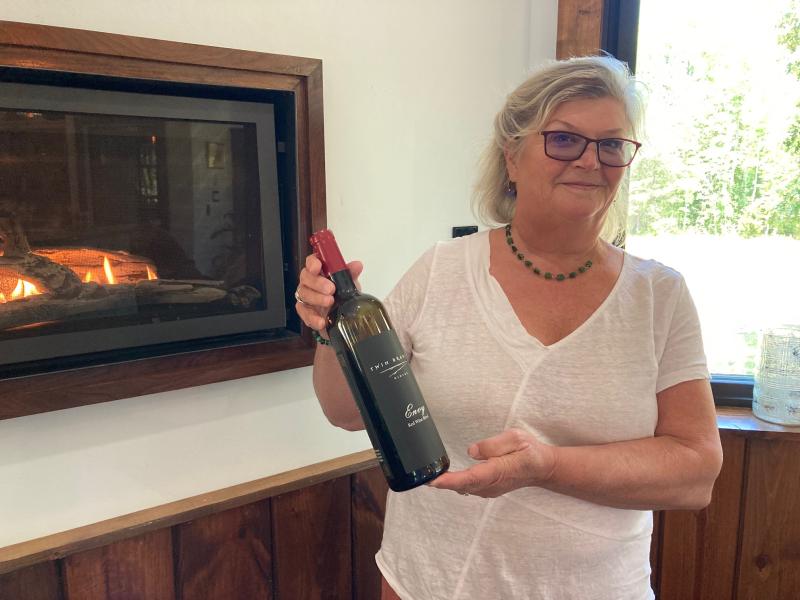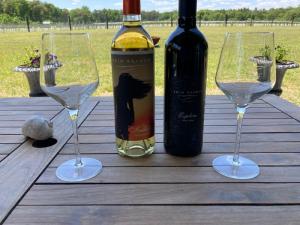Getting to Twin Branch Winery is almost as much of an adventure as the wine-tasting experience itself.
Turning off Route 16 in Milton onto Saw Mill Road, the sign beckons you to a dirt road that winds ... and winds ... and winds. Knowing that the winding may test people’s patience, a sign has been put out: “Stop wining, you’re almost there.”
Over the farm field and through the woods is Twin Branch’s tasting room, which includes indoor and outdoor seating, and outdoor games like cornhole and lawn bowling. And it’s about at that point that the whining stops and the wining begins.
Owner Shauna Thompson said the winery, which opened April 28 on a parcel that her family has owned for decades, has been a long time coming. The portion of the property where the winery is located is about 27 acres.
“We started talking about it maybe 20 years ago. This piece of property was fallow for almost 40 years because it was too small to bring the farm equipment anymore. It’s also high, which is good for the vines because they need deep roots. We’ve done an incredible amount of work here because it was all overgrown. There was no electric. There was no water,” she said.
Among that work was the tasting room itself, which Thompson said was a home owned by a woman named Bernice Harmon.
“Apparently, during the blue law years, she would go out and buy beer and alcohol, and people could come back here and get beer and alcohol,” she said. “When we decided to do it, we lowered the basement, raised the roof and raised the floor above the basement, and then we raised the room upstairs.”
The basement of the tasting room is now the home of Twin Branch’s wine storage cellar. The winemaking itself is in a building across the dirt road from the tasting room.
Thompson said the winery has about 4,500 vines, with the first planting in 2013 and another major planting this year just before opening. She said the property has about 10 more acres to plant; she plans to farm those acres next year. Growing grapes in Delaware comes with its own challenges, including the summer heat and humidity, lack of coastal breezes to dry the grapes, mildew and tree disease. And if growers get through that, there are always critters like birds and raccoons that will eat the grapes. A grape-growing season will usually last from April through September. While grapes can be grown just about anywhere, Thompson said the weather is a big reason why so much winemaking takes place in central California. She said it takes about 630 grapes to make a glass of wine, although it can take more.
Winemaking is a relatively straightforward process: grapes are harvested, crushed and fermented. The resulting liquid is aged and undergoes what Thompson called racking, the process of transferring wine from one vessel to another, letting the sediment fall out.
It wouldn’t be wine without cheese. On that count, Twin Branch has teamed up with First State Charcuterie to provide cheeses and crackers for tasters. Weekends also include live acoustic music. Take-home bottles are also available. Thompson said she was looking for Twin Branch to be a relaxing atmosphere, and so far, the early reviews have been great.
“People are comfortable. They’re also meeting other people. I’ve noticed it a lot. Two tables will be sitting outside and they will start talking to each other,” she said.
Twin Branch Winery is open Friday through Monday from noon to 7 p.m. For more information, go to twinbranchwinery.com.
Ryan Mavity covers Milton and the court system. He is married to Rachel Swick Mavity and has two kids, Alex and Jane. Ryan started with the Cape Gazette all the way back in February 2007, previously covering the City of Rehoboth Beach. A native of Easton, Md. and graduate of Towson University, Ryan enjoys watching the Baltimore Ravens, Washington Capitals and Baltimore Orioles in his spare time.




























































